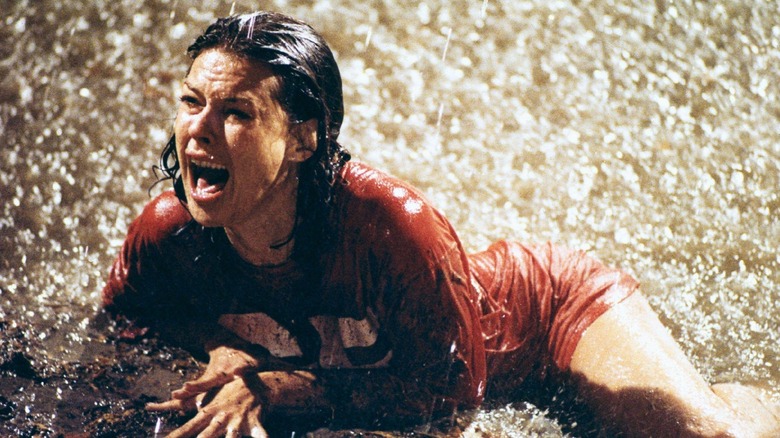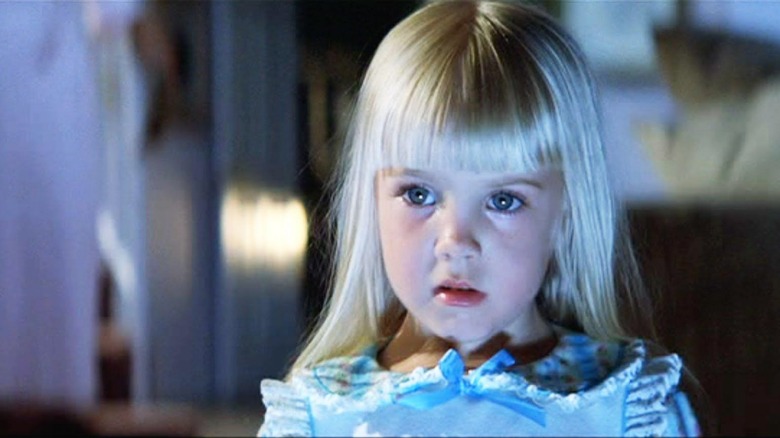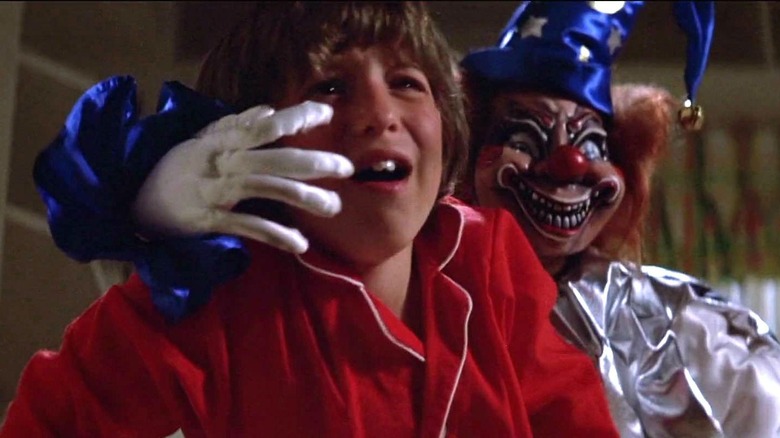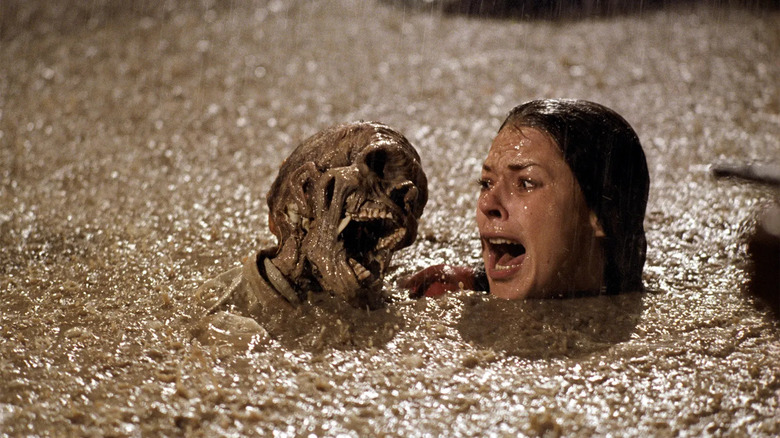Poltergeist's 'Dead Pool' Scene Was As Gruesome To Shoot As Its Name Implies
The '80s was a pretty scary time to be a kid. Over in the United Kingdom, we were routinely terrified by grim public information films and even educational content like "Dark Towers" and "The Boy From Space" were pretty hair-raising for a class full of eight-year-olds at the time. Then you had "Watership Down," a tale of bunny brutality that inexplicably received a U (Universal) certificate and scarred an entire generation for life.
Unlike the United States, we didn't get our 12 certificate (the British equivalent of the PG-13) until 1989, which meant big Hollywood movies like "Gremlins" and "Indiana Jones and the Temple of Doom" were still available to rent with the family-friendly PG rating. As a result, many impressionable '80s kids were traumatized by nasty little creatures trashing Christmas and a cult leader ripping out someone's still-beating heart well before they were equipped to deal with such stuff.
Even those films were nothing compared to "Poltergeist," which brought supernatural terrors into an ordinary family home via the telly, that comforting box most of us sat around for a few hours every evening. Tobe Hooper's haunted house thrill ride was packed with state-of-the-art special effects, but it was the humdrum setting that really made it scary. It wasn't set in a spooky old mansion or drafty castle, it was set in a nice suburban home that, even on my side of the Atlantic, was recognizably the kind of house many of us lived in. It felt like something that could happen to us.
"Poltergeist" turned 40 this year, and it still rocks, with an entertaining build-up of spooky moments before going properly bonkers in the breathless, ghoulish finale. During that full-bore last act, one of the stars found shooting the scene even more gruesome than she imagined.
So what happens in Poltergeist again?
"Poltergeist" opens in a sunny Californian new-build suburb, the last place you'd expect a force twelve haunting to occur. Steve Freeling (Craig T. Nelson) is a real estate salesman, making decent money selling tract homes just like his own while his wife Diane (JoBeth Williams) stays at home looking after their three kids, sassy teenager Dana (Dominique Dunne), plucky middle child Robbie (Oliver Robins), and angelic Carol Anne (Heather O'Rourke).
They're a happy family, but their domestic routine takes an unexpected supernatural turn when Carol Anne starts talking to a presence in the television static. The "TV people" soon invite themselves into the Freeling home, and the family initially react with amusement and surprise when the unseen spirits bend cutlery and start moving furniture around.
Their amazement soon turns to terror when a heavy storm descends on the house and the evil-looking tree in the yard smashes through the bedroom window and snatches Robbie. It turns out to be a diversionary tactic from their supernatural visitors: While Steve and Diane are rescuing their son, Carol Anne is sucked into a glowing portal in her closet.
Realizing she is somehow stuck with the TV people on the other side of the screen, the family accepts help from a team of paranormal investigators and Tangina (Zelda Rubenstein), a medium. She determines that Carol Anne is stuck in limbo with spirits who have yet to cross over into the afterlife and a malevolent force known as "The Beast" covets her lifeforce. Can she help the family bring Carol Anne back? If so, will the spirits take it lying down?
Does Poltergeist still hold up?
Now we live in a state of perpetual '80s nostalgia, "Poltergeist" is likely to work just as well with younger viewers hooked on "Stranger Things" as it did for those who grew up with it the first time around. Many Spielberg movies of that period (both as producer and director) gave us that comforting kids-on-bikes version of American suburbia, and "Poltergeist" really makes the most of that cozy everyday environment. Not only does the setting seem very safe, but the Freeling family are also incredibly down-to-earth and likable. So many horror movies focus on protagonists who are troubled, damaged, or haunted from the outset, but these guys are just a regular family with no apparent hang-ups.
A large part of their appeal is the performances, especially from Nelson and Williams, who are such loving, cool, and caring parents. They seem like the kind of mum and dad who genuinely would make the journey to Hell and back for their children, and the ghostly abduction of Carol Anne means they almost have to go that far. Steve and Diane are so grounded and relatable that it's impossible not to feel their desperation and sense of loss for their little girl.
Having given us a normal family who are really easy to root for, "Poltergeist" escalates very quickly from a little spoon-bending to a wild array of paranormal activity in the space of a few scenes, and then Spielberg and Hooper go all-out for the second hour: Killer clowns, evil man-eating trees, eerie spectral visions, creeping cuts of meat, and a real show-stopping shock moment as one of the investigators hallucinates ripping his own face off. All these incarnations are brilliantly realized by Industrial Light and Magic's Oscar-nominated effects, which are of their time but hold up incredibly well today.
The effects were a little too realistic in the pool scene
After Tangina has helped Diane bring Carol Anne safely back, she declares: "This house is clean." And so it seems for a few minutes before The Beast launches a ferocious surprise attack while Steve and Dana are out of the house and Diane is home alone with the kids. Trying to take Carol Anne again, the creature drives Diane out of the house into the pouring rain. Absolutely frantic, she slips in the mud and falls into the flooded pit recently dug for their new swimming pool. She quickly discovers that she's not alone in the water as a bunch of decomposing skeletons suddenly bob to the surface.
It is probably the film's second biggest shock moment after the face-peeling incident, and it absolutely terrified me as a kid. It was even worse for Williams, who later found out that the skeletons were even more realistic than she first thought (via Vanity Fair):
"I always assumed that the skeletons were made by the prop department. A few years later, I ran into one of the special effects guys, and I said, 'You guys making all those skeletons, that must have been really amazing.' He said, 'Oh, we didn't make them, those were real.' I said, 'What?' He said, 'Yeah, they were real skeletons.'"
Luckily, they were the kind of bleached clean skeletons often found hanging in classrooms, and the makeup artists just dressed them up to look like decomposing cadavers, so at least the rotting flesh part wasn't real. Combined with the hoary old myth that the set was cursed, the swimming pool of real skeletons adds just another layer of creepiness to the legend of "Poltergeist."



